A true threat is a statement that is meant to frighten or intimidate one or more specified persons into believing that they will be seriously harmed by the speaker or by someone acting at the speaker’s behest.
True threats — like obscenity, child pornography, fighting words, and the advocacy of imminent lawless action — constitute a category of speech that is not protected by the First Amendment. The U.S. Supreme Court has mentioned the true threats category only in a handful of cases.
For example, in Virginia v. Black, the Supreme Court declined to rule that cross-burning was protected expressive speech under the First Amendment when such an activity was intended to intimidate, reasoning that sometimes it can constitute a “true threat.” In the wake of Virginia v. Black, it seems clear that the speaker must actually intend, through a statement, to instill fear in the recipient.
Read more from our True Threats entry.

